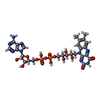+ Open data
Open data
- Basic information
Basic information
| Entry | Database: PDB / ID: 6lz3 | |||||||||||||||||||||||||||||||||||||||
|---|---|---|---|---|---|---|---|---|---|---|---|---|---|---|---|---|---|---|---|---|---|---|---|---|---|---|---|---|---|---|---|---|---|---|---|---|---|---|---|---|
| Title | Structure of cryptochrome in active conformation | |||||||||||||||||||||||||||||||||||||||
 Components Components | Cryptochrome2 | |||||||||||||||||||||||||||||||||||||||
 Keywords Keywords | FLAVOPROTEIN / cryptochrome / photoreceptor / photosignaling / PLANT PROTEIN | |||||||||||||||||||||||||||||||||||||||
| Function / homology |  Function and homology information Function and homology informationblue light photoreceptor activity / nucleobase-containing compound metabolic process / response to stress Similarity search - Function | |||||||||||||||||||||||||||||||||||||||
| Biological species |  | |||||||||||||||||||||||||||||||||||||||
| Method | ELECTRON MICROSCOPY / single particle reconstruction / cryo EM / Resolution: 3.2 Å | |||||||||||||||||||||||||||||||||||||||
 Authors Authors | Shao, K. / Zhang, X. / Zhang, P. | |||||||||||||||||||||||||||||||||||||||
 Citation Citation |  Journal: Nat Struct Mol Biol / Year: 2020 Journal: Nat Struct Mol Biol / Year: 2020Title: The oligomeric structures of plant cryptochromes. Authors: Kai Shao / Xue Zhang / Xu Li / Yahui Hao / Xiaowei Huang / Miaolian Ma / Minhua Zhang / Fang Yu / Hongtao Liu / Peng Zhang /  Abstract: Cryptochromes (CRYs) are a group of evolutionarily conserved flavoproteins found in many organisms. In plants, the well-studied CRY photoreceptor, activated by blue light, plays essential roles in ...Cryptochromes (CRYs) are a group of evolutionarily conserved flavoproteins found in many organisms. In plants, the well-studied CRY photoreceptor, activated by blue light, plays essential roles in plant growth and development. However, the mechanism of activation remains largely unknown. Here, we determined the oligomeric structures of the blue-light-perceiving PHR domain of Zea mays CRY1 and an Arabidopsis CRY2 constitutively active mutant. The structures form dimers and tetramers whose functional importance is examined in vitro and in vivo with Arabidopsis CRY2. Structure-based analysis suggests that blue light may be perceived by CRY to cause conformational changes, whose precise nature remains to be determined, leading to oligomerization that is essential for downstream signaling. This photoactivation mechanism may be widely used by plant CRYs. Our study reveals a molecular mechanism of plant CRY activation and also paves the way for design of CRY as a more efficient optical switch. | |||||||||||||||||||||||||||||||||||||||
| History |
|
- Structure visualization
Structure visualization
| Movie |
 Movie viewer Movie viewer |
|---|---|
| Structure viewer | Molecule:  Molmil Molmil Jmol/JSmol Jmol/JSmol |
- Downloads & links
Downloads & links
- Download
Download
| PDBx/mmCIF format |  6lz3.cif.gz 6lz3.cif.gz | 359.2 KB | Display |  PDBx/mmCIF format PDBx/mmCIF format |
|---|---|---|---|---|
| PDB format |  pdb6lz3.ent.gz pdb6lz3.ent.gz | 292.1 KB | Display |  PDB format PDB format |
| PDBx/mmJSON format |  6lz3.json.gz 6lz3.json.gz | Tree view |  PDBx/mmJSON format PDBx/mmJSON format | |
| Others |  Other downloads Other downloads |
-Validation report
| Summary document |  6lz3_validation.pdf.gz 6lz3_validation.pdf.gz | 1.3 MB | Display |  wwPDB validaton report wwPDB validaton report |
|---|---|---|---|---|
| Full document |  6lz3_full_validation.pdf.gz 6lz3_full_validation.pdf.gz | 1.4 MB | Display | |
| Data in XML |  6lz3_validation.xml.gz 6lz3_validation.xml.gz | 62.2 KB | Display | |
| Data in CIF |  6lz3_validation.cif.gz 6lz3_validation.cif.gz | 95.3 KB | Display | |
| Arichive directory |  https://data.pdbj.org/pub/pdb/validation_reports/lz/6lz3 https://data.pdbj.org/pub/pdb/validation_reports/lz/6lz3 ftp://data.pdbj.org/pub/pdb/validation_reports/lz/6lz3 ftp://data.pdbj.org/pub/pdb/validation_reports/lz/6lz3 | HTTPS FTP |
-Related structure data
| Related structure data |  30022MC 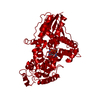 6lz7C M: map data used to model this data C: citing same article ( |
|---|---|
| Similar structure data |
- Links
Links
- Assembly
Assembly
| Deposited unit | 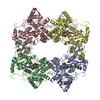
|
|---|---|
| 1 |
|
- Components
Components
| #1: Protein | Mass: 77609.125 Da / Num. of mol.: 4 / Mutation: W368A Source method: isolated from a genetically manipulated source Source: (gene. exp.)   #2: Chemical | ChemComp-FAD / Has ligand of interest | Y | Has protein modification | N | |
|---|
-Experimental details
-Experiment
| Experiment | Method: ELECTRON MICROSCOPY |
|---|---|
| EM experiment | Aggregation state: PARTICLE / 3D reconstruction method: single particle reconstruction |
- Sample preparation
Sample preparation
| Component | Name: Tetrameric complex of ZmCRY1c / Type: COMPLEX / Entity ID: #1 / Source: RECOMBINANT |
|---|---|
| Source (natural) | Organism:  |
| Source (recombinant) | Organism:  |
| Buffer solution | pH: 8 |
| Specimen | Embedding applied: NO / Shadowing applied: NO / Staining applied: NO / Vitrification applied: YES |
| Vitrification | Cryogen name: ETHANE |
- Electron microscopy imaging
Electron microscopy imaging
| Experimental equipment |  Model: Titan Krios / Image courtesy: FEI Company |
|---|---|
| Microscopy | Model: FEI TITAN KRIOS |
| Electron gun | Electron source:  FIELD EMISSION GUN / Accelerating voltage: 300 kV / Illumination mode: OTHER FIELD EMISSION GUN / Accelerating voltage: 300 kV / Illumination mode: OTHER |
| Electron lens | Mode: OTHER |
| Image recording | Electron dose: 49.8 e/Å2 / Film or detector model: GATAN K2 SUMMIT (4k x 4k) |
- Processing
Processing
| CTF correction | Type: NONE |
|---|---|
| Symmetry | Point symmetry: D2 (2x2 fold dihedral) |
| 3D reconstruction | Resolution: 3.2 Å / Resolution method: FSC 0.143 CUT-OFF / Num. of particles: 108059 / Symmetry type: POINT |
 Movie
Movie Controller
Controller







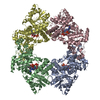
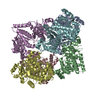
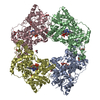
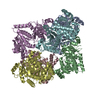


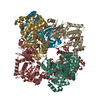
 PDBj
PDBj
